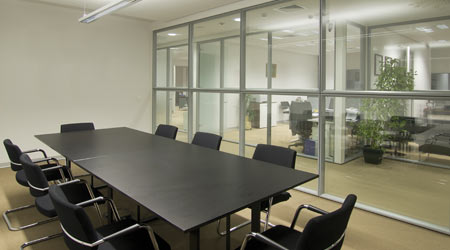 In conference rooms, it’s important that people inside the space can hear what is said — and that people outside can’t.
In conference rooms, it’s important that people inside the space can hear what is said — and that people outside can’t.How to Get Good Acoustics from Floor to Ceiling
Here are some important best practices for examining how your floors, ceilings, and soundmasking systems all contribute to good (or really bad) acoustics in your office space.
Many office spaces are unintentionally terrible acoustical performers. Consider the 1880s-era factory that’s been repurposed into chic office space with exposed brick, heavy timbers, and exposed ductwork. At the other end of the spectrum, think of a brand new building with a design aesthetic that’s modern and austere, with lots of glass, galvanized steel, and an exposed deck to achieve the desired look.
In both situations, the multitude of hard surfaces creates a potentially noisy, reverberant space.
“I find that we’re having to get creative, finding new [design-oriented] products that still have the NRC rating,” says Salenger.
In those situations, particularly spaces that feature an exposed deck and therefore rule out the use of sound-absorbing ceiling tiles, many facility managers are turning to clouds, canopies, or other noise-absorbing solutions that don’t undermine design aims.
One option is application of sound-absorbing materials, usually a sprayed application or mounting of panels in select locations, directly to the deck. Another strategy is the use of clouds and canopies to absorb sound. The Sabin rating, which shows how well a square foot of absorbent material absorbs sound, can help determine how much sound absorbing material is required.
Canopies, clouds, and other similar solutions almost always require some outside support from consultants. The reasons are fairly straightforward: The products are three-dimensional (as opposed to the two dimensions of walls, ceiling tiles, and floors), making the mathematics of calculating NRC and sabins more complex. They’re also frequently used to achieve both acoustic performance and interior design considerations, a delicate and subjective balance. And lastly, when positioned improperly or without adequate coverage, clouds can allow sound from above the exposed deck to penetrate into the space below.
Absorbing sound underfoot
The floor is often an afterthought for sound absorption, but it does play a role, for example by reducing reverberation. “In the modern office, specifying materials that reduce reverb is essential,” says Chip DeGrace, vice president of workplace applications at Interface Flooring.
DeGrace says that a mix of materials, from soundmasking to clouds to carpeting, is essential, particularly when tailoring space to a specific activity or use. “Understand all the groups, and all the activities,” he says. “Understand the pragmatic considerations, too.”
Pragmatic issues are particularly important when it comes to selecting flooring. Consider a conference room that was also used for working lunches. The facility manager was tired of spilled coffee and crushed mustard packets soiling the carpeting. For that space, luxury vinyl tile that used a felted backing provided an easy-to-clean surface with improved acoustic performance.
Related Topics:














